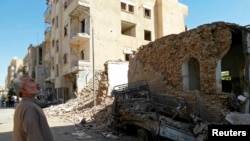Nearly three times more Syrians are scrambling to survive in besieged towns than the U.N. is estimating, warns an American non-profit whose members are medical professionals of Syrian descent. The Syrian American Medical Society claims in new a report that 650,000 Syrians are currently besieged in 49 communities by government forces and are facing a slow death.
The report was shared last week with U.N. officials just days after the civil war, which has left more than 200,000 dead, reached a grim milestone - its fourth anniversary.
The U.N. calculates that around 212,000 Syrians are living in eleven besieged areas that have little or no access to humanitarian aid. But the medical professionals say this is a gross underestimation and that another 38 towns and communities have been under long-term sieges enforced by forces loyal to Syrian President Bashar al-Assad.
Zaher Sahloul, president of the Syrian American Medical Society, told the Associated Press: “We’re not talking about quote-unquote terrorists, we're talking about families who have nothing to do with armed groups.”
The society says pro-Assad forces are using siege tactics to starve people out. Last month, in an interview with the BBC, President Assad insisted his forces are not besieging any towns, claiming that if weapons are getting into those towns, they couldn’t be described as under siege.
Siege impact
In an attempt to illustrate the deadly impact of the civil war, which started in March of 2011 when Assad started repressing civilian protests demanding reform, the report details 560 civilians who have died in besieged areas, featuring photographs of 345 of them. The group says there has to be more vigorous action from the international community - a plea reflected by other charities and aid agencies.
“We have to break the siege and to break the silence,” Sahloul insists. Some aid officials, though, say the numbers to a certain extent are irrelevant, arguing there are a lot of people starving and there’s no point in getting into an argument over statistics.
Former British Foreign Secretary and President of International Rescue Committee, David Miliband, is urging the U.N. Security Council to appoint permanent coordinators for humanitarian relief to deal with the crisis. The fourth anniversary of the Syrian crisis should remind the international community not only of the suffering of Syrians, but of its failure to resolve it, he said.
According to Sahloul, sieges impact the young and old the most as they are more vulnerable to disease.
Last week, Anthony Lake, the executive director of the United Nations Children's Fund (UNICEF), lamented the plight of children trapped in the Syrian conflict, saying, “see this horror through the eyes of the children who are living through it. Their homes bombed or abandoned. Loved ones and friends lost. Their education interrupted, or never begun. Their childhoods stolen from them.”
International deadlock
But with no agreement among U.N. Security Council members - Russia and China have vetoed resolutions on the conflict - there seems little relief, let alone a resolution, in sight. On Friday, the U.S. ambassador to the U.N. Samantha Power singled out Russia for criticism. “The things we think are indispensable, Russia is not prepared to do.” She accused Moscow of shielding Assad from pressure and allowing him to do “almost whatever he wants.” Both Russia and China have also blocked efforts to refer Syrian government officials to the International Criminal Court for war crimes.
Government forces aren’t the only ones being accused of targeting civilians. Syrian militias, some Western-backed, and jihadists have indiscriminately targeted civilians, the non-profit Human Rights Watch claimed Monday. The rights group says it has documented dozens of opposition attacks against civilians in government-held territory in what it describes as a race to the bottom. “Civilians are paying the price, be it in government or rebel-held areas, with an inadequate international response,” said the group’s deputy Middle East director, Nadim Houry.
Houry accused rebels of “mimicking the ruthlessness of government forces.” The rights group cited cases of indiscriminate shelling and car bombs in the countryside of Damascus and Homs. “Besides being indiscriminate, many of these attacks seemed primarily intended to spread terror among the civilian population,” she says.
Among the worst car bombings was one in October last year outside a school in the Akrameh district of Homs city that killed more than 45 children.
Airstrikes also blamed for many deaths
Meanwhile, the Syrian Observatory for Human Rights, a London-based monitoring group that relies on activists on the ground to gather information, says it has documented the deaths of 1,953 people from U.S.-led coalition airstrikes on Syria since they started in September. Sixty-six of them were civilians - including 10 children and 6 women - killed in airstrikes on oil fields and refineries in the provinces of al-Hasakah, Der-Ezzor, and al-Raqqa.
Of the combatants killed, the Syrian Observatory says 1,796 were Islamic State militants, mostly of them non-Syrian, and 90 fighters were members of al-Qaida’s affiliate in Syria, Jabhat al-Nusra.
But the director of the Syrian Observatory, Rami Abdulrahman, cautions “We believe that the real number of casualties in Islamic State is more than our number because there is absolute secrecy on casualties and due to the difficulty of access to many areas and villages that have witnessed violent clashes and bombardment.”






